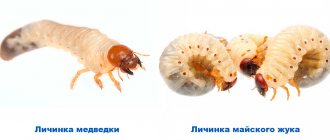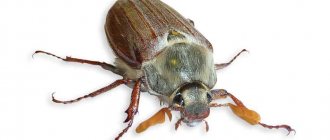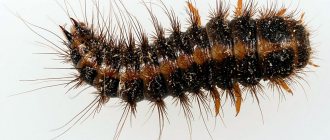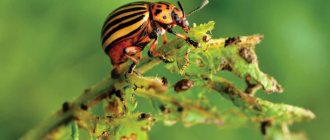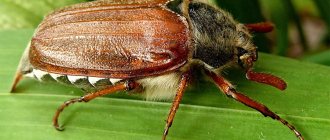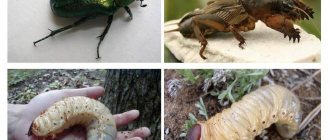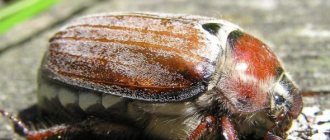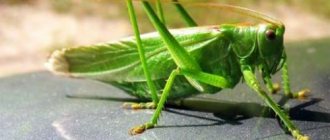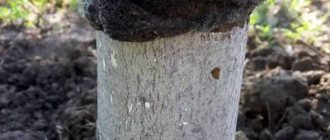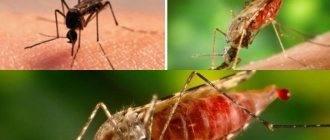During the summer, gardeners have to deal with various pests. This is why the mole cricket is especially dangerous - an insect that destroys not only seeds, but also the root system of plants. The cockchafer, or rather its larvae, poses no less of a threat. They dig tunnels in the ground, literally gnawing plants at the root. From which the latter begin to wither. Even an inexperienced gardener can see the difference between the larvae of the cockchafer and the mole cricket in the photo below. You can learn more about the distinctive features of these creatures from this article.
Mole cricket egg laying
After the mating season and mating of two insects, the female begins to build a nest.
The structure is a round cave with a diameter of approximately 10 cm. Such a cave is located in the soil, at a depth of about 15 cm it contains up to five thousand eggs. To prevent molding, the female periodically turns over the clutch, inspects and makes a selection. Eggs are slightly oval balls, similar to grains. Their color is beige or brownish with a coating. From the outside, the mole cricket masonry resembles an ant masonry enlarged in size.
The insect does not make deep nests due to the fact that enough heat reaches them through the soil layer. Therefore, detecting masonry is not difficult; just walk around the area looking for characteristic hummocks. The larvae hatch in 14-21 days.
We can say that the larval form of the mole cricket is similar to long-bodied six-legged spiders or mutated crickets. The size of the larva is up to 15 mm. The structure of the front paws (they are turned outward) allows them to rake the earth in front of them.
In general, the larva differs little from the adult specimen, except in size. Active development includes five molts, after which the larva is considered sexually mature and capable of reproducing offspring.
The larval form does not develop in one season, so it overwinters in this form until next spring next to adult pests. The thickness of the fat layer will determine whether the insect will survive the winter cold. She doesn't really like the frost. Cold also affects future fertility.
How to fight?
If you do not immediately begin to fight the mole cricket, then its cubs and adult pests will remain in place for all subsequent seasons. Such a pest can easily dig holes in any type of soil, so a mole cricket can make a hole for itself, regardless of weather conditions.
It is necessary to fight the mole cricket insect and its larvae as quickly as possible, since both adults and larvae of this insect are famous for their very high gluttony, which means that they are capable of damaging the root system of a large number of plants in a short period of time.
Currently, there are several effective means to help get rid of this pest. The first of them is agrotechnical. It consists in the fact that it is necessary to prepare the soil for planting in advance.
In early spring and late autumn, the ground needs to be plowed and dug up. Thus, the mole cricket's egg clutches and larvae will be destroyed, and the underground passages made will also be disrupted.
Planting plants such as marigolds around the perimeter of the garden can permanently get rid of the mole cricket and its larvae. The fact is that the smell of this plant repels underground pests.
Another environmentally friendly way to get rid of mole crickets is to lure the insects into vegetable oil. A couple of drops of vegetable oil are poured into the hole left by the bear, after which a glass of water is poured there. In a couple of minutes the mole cricket will appear on the surface of the soil, and after a few more minutes it will die.
The pest can also be controlled using modern insecticides. The smell of the granules attracts insects, after which they eat the bait left for them and, getting out, immediately die
When using this method, it is very important to collect all poisoned mole crickets, since birds can also be poisoned by these insects
Mole cricket is a harmful and dangerous insect for crops, capable of rapid reproduction.
That is why it is important to fight both the mole cricket itself and the larvae and eggs. Fighting the pest is difficult, but it is worth taking the time to destroy the insect and thus save most of the crop
All methods of fighting Medvedka
Having seen tubercles and dead plants on the plot of land, a mole cricket has definitely settled in your home. There are traditional and modern methods of destruction to eliminate it, but it cannot be destroyed immediately; it will take two to three years.
To effectively kill the parasite, it is better to combine several control methods. At the initial stage, it would be better to use a method that will not contaminate the soil with plants with caustic chemicals.
- 1. repellent,
- 2. loosening the soil,
- 3. destruction of nests,
- 4.use of special traps,
- 5. chemical and biological preparations.
To loosen the soil, try the agricultural method
This method is used when spring comes, after the snow has melted, thus destroying the dug passages. It becomes more difficult for parasites to move around the area. The destruction of clutches, adults and their larvae is also underway.
It is important that the loosening depth is 15 cm. And repeat digging after the growing season
Another control method is a manure trap.
In the fall, you need to dig 50 cm holes around the garden, filling them with fresh organic fertilizers. And when the cold comes, the parasites will move into these pits to secure a place for themselves for the winter. After waiting for severe frosts, dig up the manure and spread it on the surface, and the cold will kill them.
There is another option: when you see the tunnels, pour water with oil or soap there, the mole cricket from such a cocktail will come to the surface, and then you catch it to destroy it. But this is the most ineffective way.
There is an interesting method with alcohol
The mole cricket is very attracted to the smell of beer; kill the beetles with the help of this drink. Take a glass bottle one-third full and bury it at a slight angle, so that there is a gap of 1-2 cm at the neck. At night, the smell of beer will attract its lover, who, intoxicated by the smell, will fall into the bottle, but will not come back out. Accumulated beetles in a bottle can be easily eliminated.
Scaring method
It is better to use it to prevent beetles from entering your area. This method consists in the fact that parasites cannot tolerate certain odors, such as garlic, chrysanthemums, pine needles, marigolds, coriander, onion peels, rotten fish. How to use pine needles - the branches need to be cut into pieces, spread around the garden and sprinkled with earth so that the smell lasts longer. Onion peels - pour ten liters of water over one kilogram of onion peels and leave for 10 days, then add another 50 liters. And water the soil after rains, treat once every 10 days. Rotten fish - fish that you don’t mind burying in holes when planting plants; the rotten smell will scare away insects.
Obstacle method
You can also create physical obstacles for them to fight, since the mole cricket is not able to overcome some difficulties along the way. This is a way to prevent beetles from feasting on plant roots. You need to take nylon tights, make them into bags filled with earth. You plant seedlings in it. The edges of the container should protrude 3 cm from the soil surface. This way you protect tomatoes, eggplants, etc. from the pest.
If traditional methods are not effective in eliminating the enemy, then a number of different chemical preparations are provided to your attention: Anitimedvedka, Medvetox, Rembek, Medvetsid. Use medications strictly according to instructions! And use chemical protection products.
In addition to chemical weapons, there is also a biological remedy against the mole cricket. Biological drugs infect parasites with harmful organisms. For example: Nemabact, Boverin
Attention, do not use the drug frequently, as they develop immunity to these poisons
To prevent the mole cricket from becoming a permanent resident in your garden, you need to carry out preventive maintenance of the area. 1. Digging up the area in spring and autumn, 2. Replace chicken droppings with chicken droppings, it is safer, 3. Plant and place repellent plants in the garden and around the entire perimeter, 4. Monitor the humidity level and do not allow it to exceed the norm.
Biological products
Proven biological products are also available for sale in specialized stores, which are completely safe for plants and people, but allow you to get rid of beetles and their larvae in the garden.
Nemabakt for the fight against Khrushchev
The drug Nemabact was created using nematode worms, which, after being introduced into the soil, actively attack the larvae of the cockchafer. After just 1-3 days, their number will become much smaller, and then it will allow you to get rid of them forever. Worms introduced into the soil maintain balance for 2 years.
It is used when watering the soil (morning and evening), it must first be diluted in a ratio of 1:100, the optimal air temperature should be from +10 to +26°C with high humidity.
Nematodes are stored in a special biosoil called Bioshield. 5 liters of prepared soil with nematodes are designed to treat 15 square meters. m of land in the garden. You can buy such a drug only in specialized stores and must store it only under certain conditions specified in the instructions.
On a note!
Scientists have discovered an interesting feature of beetles - they cannot tolerate high levels of nitrogen in the soil. Therefore, for prevention purposes, you can use planting white clover in the garden and in the garden in tree trunks. In its root system there are special bacteria that can absorb nitrogen from the air and then accumulate it in the ground. Thus, the concentration of nitrogen in the soil increases.
What does a mole cricket and its larvae look like?
The mole cricket is a species of Orthoptera, does not have clear geographical boundaries of habitat, and is found wherever conditions allow. The peak of active life for mole crickets occurs when night has fallen, and during the day they sleep in their earthly houses. If the pest eats well, the mole cricket can reach up to eight centimeters in length.
If you see a parasite in your area that looks like a shrimp or locust with tentacles, then it is a mole cricket. In addition to her interesting appearance, she has the ability to quickly run, fly, and swim. He uses these qualities when he really needs them, but mostly likes to dig deeper into the ground. And in order to leave her offspring, the female makes depressions in the ground so that the sun warms the clutch well, and so that the rays successfully fall on the clutch, the beetle clears the ground of plants, eliminating obstacles to the rays.
A clutch can contain up to a hundred eggs. They are shaped like oblong grains and the color varies from beige to light brown. When the larvae emerge from the eggs, their body is very similar to the adult, but much lighter. Many people imagine it as a white worm, but it is not so! Juveniles are full of energy and very voracious. They develop for about 2-2.5 years, and when the last molt has passed, they are ready to reproduce. They wait out the winter in the ground.
Description of the pest
The mole cricket is an insect, a representative of the order Orthoptera. The adult specimen is characterized by significant size (up to 6 cm). For orientation in space, whiskers are provided, and the limbs are designed so that the insect has the opportunity to dig the soil. Life expectancy is 5 years.
An adult mole cricket feeds on plant roots and can damage up to 15 plants per night
The mole cricket is distributed throughout Russia (with the exception of the regions of the North and East), Europe, and Asia. Acceptable conditions for existence in the ground are from +10 degrees or more. The pest is nocturnal, during which time the mole cricket climbs to the soil surface. The insect reaches a soil depth of up to 2 m. It overwinters closer to the surface (at a level of no more than 15 cm from the soil surface). This insect moves quickly, can swim, fly (rises to a height of up to 5 m).
Signs of appearance
Considering that pests do not appear during the day, they are not easy to detect. However, according to some signs, it is quite possible to assume the appearance of a mole cricket:
- General destruction of seedlings: leaf lethargy appears, plants wither;
- Violation of the integrity of root crops;
- The soil becomes loosened, piles of soil and passages are revealed;
- Holes in the ground.
External signs of eggs
The pest reproduces very quickly, as there are about 500 eggs in one clutch. The mating season lasts several months: from May to July. Eggs of the mole cricket pest are found under a layer of soil, in manure or a garbage heap. The insect builds a nest. This is a small chamber: approximately 6x6 cm. The walls are sealed. The nest of a mole cricket contains beige or yellow-brown offspring.
The chamber is filled with yellow or light brown eggs, similar to ant eggs, but larger.
Externally, the eggs resemble ant eggs. However, the larger size makes it possible to verify that these are the offspring of mole crickets. The egg reaches a length of 3.5 mm. The incubation period lasts about three weeks. In order for the offspring to develop normally, the mole cricket sets up its nest at a depth of no more than 15 cm from the surface of the earth. This ensures the supply of oxygen. The female takes care of the offspring and periodically turns the eggs, which reduces the risk of mold.
Description of the larva
Considering that an adult insect lives on average 5 years, it takes 1-2 years for the offspring to develop. During this period, the young go through 4 stages. After emerging from the shells, mole cricket larvae develop to a size of 1.5-3.5 cm. Formation in more acceptable conditions (ambient temperature, opportunity to feed) occurs faster.
With each moult, it becomes more and more similar to an adult: the body darkens and takes on shape.
In terms of external characteristics, the mole cricket larva resembles an adult. The only difference is the sizes. Thus, young animals are half as long as mature insects. The larva goes through several stages of molting. Gradually she reaches sexual maturity and acquires the ability to reproduce. In one season, as happens with most insects, the offspring of the mole cricket does not have time to develop and remains to overwinter, remaining in the larval form.
During the cold season, some of the offspring die, because not all individuals tolerate frost well. This ability is influenced by the supply of nutrients accumulated during the warm season. This factor also determines the female’s fertility in the future. Immediately after emerging from the eggs, the larva begins to feed. The source of food for her at this stage is the remains of the protective shell, as well as salivary secretions, which the female used to build the chamber/nest.
When the offspring grows up (closer to autumn), the source of food is the food familiar to adult mole crickets: roots, root crops, lower sections of the stems of plantings. As they develop, the larvae become more voracious. At first, the offspring move along ready-made passages dug by the parent insects. When the larvae's capabilities increase, they begin to dig the ground on their own. This happens forcedly, as there is a need to find new sources of food.
Natural enemies of mole crickets
Well-fed, slow-moving insects are easy prey for many feathered hunters: rooks, starlings and even crows are not averse to putting their long beaks into the ground and catching a couple of mole crickets for breakfast.
Roller with mole cricket.
Hoopoe with mole cricket.
Hoopoe with mole cricket.
A white-breasted kingfisher caught a mole cricket.
Other underground inhabitants - moles, happily eat larvae and adults; hedgehogs and lizards will not refuse mole crickets. Garden ants drag mole cricket eggs into their nests, and ground beetles destroy the wingless larvae.
Mole crickets are parasitized by nematodes and some types of mites; insects are affected by fungal diseases, especially in warm winters with frequent thaws.
Behavior
The mole cricket spends most of its life underground. There it digs passages, builds labyrinths, and builds nests. It comes to the surface at dusk in warm weather. Looks for food or rises into the air to search for a male.
The body structure of the mole cricket allows it to swim on the surface of the water. She calmly overcomes a large puddle and escapes the flood. But if water gets into the burrow, the insect dies.
The heat-loving insect successfully survives winter frosts through half the soil. With the onset of heat it gradually rises to the surface. The presence of the pest in garden plots can be noticed as early as April. Paths form in the ground, footprints are visible, and plants die.
Appearance of a mole cricket larva
Experienced gardeners know how to distinguish insect larvae, but beginners have to rack their brains.
There are about 500 eggs in a mole cricket's nest. The length of each of them is from 1 to 3 mm. They have a brown, reddish color. Translucent. Under a microscope you can see a living creature in them. The larva develops in the egg for about 2 weeks. Under favorable conditions, it emerges from the shell earlier.
Initially, these are small, helpless, blind creatures that outwardly resemble a bug, but not a caterpillar. They have a reddish color. Their food is the mother's saliva and egg shells. After approximately 7 days, the first molt occurs. Mole cricket larvae increase in size and more closely resemble an adult insect, which even has wings and can fly.
The full stage of imago formation lasts about 2 years. Under favorable conditions – 1.5 years. At the last stage, the genital organs develop. The mole cricket larva has to go through about 10 molts. Each time the body length increases, more and more reminiscent of an adult beetle.
Mole cricket larvae
Main differences
Having become familiar with the appearance of each insect and the features of nest construction, we can highlight the main differences:
- The mole cricket does not go through the worm or pupa stage. It immediately appears in the form of a small insect. It has a brown color, but darkens over time. At the last stage, wings and genitals develop. All this takes about 2 years.
- May beetle larvae are white caterpillars with well-defined rings. They gradually increase in size, reaching a length of 6 cm. They have a twisted ring shape. The head is brown. There are 3 pairs of legs in the front part. This is important to remember, since similar caterpillars are found in the larvae of other beetles that do not harm crops.
On a note!
The difference between the larvae is obvious. One should take into account the fact that the cockchafer develops underground for about 3 years. The cycle continues as the weather warms up. During the first 2 years the larva does not cause much harm, but in the last year it sweeps away everything in its path and turns into a real natural disaster.
In small numbers on a plot of land, the larvae do not cause much harm. This applies to both mole crickets and the May beetle. They loosen the soil and saturate it with useful substances. However, their large numbers can negate all the efforts of the gardener.
What does a bear look like?
The mole cricket is one of the worst pests in our garden. People also call it “earthen cancer.” Most likely due to the hard front back, which looks like a crayfish shell. With its forelimbs, the insect, like a mole, makes its way underground. Some have nicknamed the mole cricket “mole cricket.” It flies and swims well, runs quickly on the surface of the earth, but is mainly located under it, crawling out at night, its characteristic drawn-out sharp sounds create a very frightening sensation, hence another popular name “top”.
By and large, for the mole cricket larva it’s the same as grinding: cabbage, potatoes, cucumbers, onions, eggplants. It settles in soil with good access to the sun, which means that all plants that will shade its hole (the size of a chicken egg) are in danger of being destroyed. The depth of the burrow is about 10-15 cm, so some gardeners, digging up the soil in the fall and spring, hope that this pest will not appear on their site. How to get rid of a mole cricket, what needs to be done? First we need to study the insect itself in order to understand what we are dealing with.
The common mole cricket is distributed throughout the European part of Russia. The most favorite habitats are moist, loose soils, along the banks of rivers and streams. In the garden, her favorite place will be planting cabbage, manure, and compost heaps. You can find out that a mole cricket has settled on your site by the winding, dug-up sections of soil after rain in late May - early June. And, of course, by plants cut off at the base. The mole cricket's nest protrudes slightly from the ground, resembling a simple hummock. Only, nothing grows within a radius of 20 cm from this hummock. The insect often checks its nest to see if everything is in order with the clutch of gray-yellow eggs slightly smaller than a pea.
Reproduction and life expectancy of mole crickets
The mole cricket nest is a unique structure. This is an intricate network of passages, which is located at a distance of 10-15 centimeters from the ground. As a rule, the mole cricket has four exits to the surface, between which there are intricate passages.
In May or June, when the air temperature is not lower than 12 degrees, adult mole crickets leave the ground and come to the surface where mating occurs. At the end of this process, they return to the depths and the females set up a nest. As a rule, the nest is located in the center of the passages.
At one time, she can lay up to 500 eggs measuring 1-2 millimeters. But in order for babies to be born, many conditions must be met: high air humidity (about 100%), warmth and ventilation of the room in which they are located.
That is why the mole cricket takes great care of its clutch. It gnaws the roots of plants so that they die on the surface, thereby increasing the area of sunlight, that is, the earth warms up more.
The female regularly opens and closes the passages to regulate air humidity and temperature. Around the nest, passages are usually dug in a spiral shape. If all conditions are favorable, mole cricket larvae
first age.
They are small, light in color, and outwardly resemble an adult, however, they do not yet have wings. And also, before the first molt they are completely blind, so they do not leave the nest yet. As soon as the time for the first molt of the young comes, they disperse for independent life.
They will have to survive several more molts in order to become an exact copy of their adult parents. As a rule, this takes about 2 years. An interesting fact is that in the adult stage, the mole cricket lives only for a year, while in the growing stage it lives for 2 years. The total lifespan of a healthy insect is 3 years.
When plants in a summer cottage wither, despite their regular watering, there is a high probability that the cause is a mole cricket. The mole cricket is a dangerous pest that can significantly spoil the harvest and destroy perennial plants.
This underground resident spoils the roots of young seedlings and adult plants, which leads to their death.
Other names for the mole cricket are cabbage weed, earthen crayfish, spinning top, mole cricket.
The insect was nicknamed the mole cricket for its brown color and a certain clumsiness in its movements. Kapustyankoy - because he loves cabbage. Due to the resemblance of the forelimbs to claws, some call this pest earthen crayfish. Spinning top - because young larvae have a grayish tint. Mole cricket - due to the fact that the insect somewhat resembles a mole and chirps at night.
Small holes in the beds, as well as loose mounds of earth, can indicate that a mole cricket lives in the garden. After rain they are visible more clearly.
If you dig 15 cm deep into the ground in these traces, you can find laid eggs of pests. Tiny eggs the size of a hemp grain will turn into larvae in 10–17 days, which will also spoil the plants in the garden.
Usually during the day, mole crickets sit in burrows, and in the evening they become active:
they make new passages, destroying plant roots along the way.
Finding and destroying a mole cricket is not the easiest task. These insects fly long distances, move on the ground and swim. Their location can be determined by the characteristic sound made in the evening and at night. It resembles the chirping of a grasshopper, only louder.
In winter,
the mole cricket lives in deep layers of the earth or compost heaps.
In the spring
it begins to become active and rises closer to the surface.
In June
, the insects mate and then lay 500–600 eggs. During this period, the pest is already clearly present in the garden, as can be seen from the signs described above - tubercles and holes in the soil.
Did you know?
Medvedkas are used in pharmaceuticals. These scary-looking insects are considered an effective cure for tuberculosis. Medvedka is also considered effective in the fight against cancer and HIV infections - its use helps improve immunity. Moreover, not all mole crickets are equally useful: Asian insects are more effective in fighting diseases.
Fighting methods
Today, gardeners and gardeners have at their disposal a whole arsenal of old folk methods for preventing and combating earthen cancer, as well as a lot of chemicals and devices that allow them to get rid of uninvited guests:
- manure traps;
- beer lures;
- soap and kerosene “baths”;
- aromatherapy;
- “onion shower”;
- installation of wind turbines;
- sound repellers;
- insecticidal preparations.
Fighting insects that survived mammoths and dinosaurs is not so easy. Adherents of organic farming are recommended to use time-tested folk methods, and only as a last resort switch to chemicals.
Mole cricket larva: description of appearance
Of course, experienced gardeners can easily distinguish the larvae of these common pests of gardens and vegetable gardens, which cannot be said about novice gardeners. Mole cricket eggs, the number of which can reach 500 pieces, have a length of 1 to 3 mm, and are distinguished by a brownish-reddish tint. The development of larvae occurs over 2 weeks. If conditions are favorable enough, then less than 2 weeks is possible.
At the initial stages, the larvae resemble their family rather than caterpillars. Moreover, they are distinguished by their reddish color. In the initial stages of long-term development, they feed on the shell and saliva of their mother. After one week they molt for the first time, after which the larva increases in size. Moreover, the appearance of the larvae is completely similar to the adult individuals.
The full development cycle until the appearance of an adult takes about 2 years, and sometimes a little less. The last stage is characterized by the appearance of reproductive organs in the larva. During the entire period of development, the larva molts about 10 times, and each time it increases in size and becomes more and more similar to an adult.
How is this parasite different?
The first feature that catches your eye is its gluttony. It is believed that its homeland is North America. He remained in the shadows for a long time until he began to rapidly destroy entire potato plantations. The pest is easy to distinguish from other similar parasites, since it grows up to 2 cm in length, and its body is covered with a shell of red or bright orange chitin.
Until the 40s of the 20th century, this pest did not yet exist in Europe. He happily eats not only potatoes, but also tomatoes, eggplants, peppers, etc. As a rule, the greatest danger is posed by the larva of the cockchafer, which penetrates into the soil along with humus. After wintering, insects climb out of the ground to the surface in search of food. Insects wait out cold and frost at a depth of about half a meter, so fighting them is not easy.
With the arrival of spring, female cockchafers begin to lay eggs, after which larvae emerge from them, and they are quite voracious and eat everything that comes in their way. Externally, the larvae look like white caterpillars with many small legs. They live for about 4 years. The larvae are armed with quite powerful jaws, as a result of which they can destroy the root system of any tree, not to mention garden crops.
Somewhere in the height of summer, the larva begins to develop into a pupa, which resembles a real adult cockchafer. By autumn, the pupa turns into an adult, which overwinters in the ground at great depths. This allows the cockchafer to survive the harshest winters.
The survivability of this parasite is associated with many factors. For example:
- In Europe, the cockchafer has practically no natural enemies, compared to its homeland.
- If there are no favorable conditions and there is not enough food, then the cockchafer can be in a state of suspended animation for 3 years. After this period, the parasite is able to come to life and begin its “violent” activity.
- Female insects lay eggs at great depths, so no agricultural measures can affect this process. Therefore, the destruction of such pests must be carried out during the period of their active life.
- The cockchafer has strong wings, so it can easily fly a distance of 10 km. As a rule, they migrate in entire colonies in search of food. At the same time, they capture significant territories.
- To destroy this parasite in a vegetable garden or garden plot, you need to put in a lot of effort and money.
Despite this, many effective means have been developed that can cope with the invasion of the cockchafer. At the same time, it must be remembered that chemical control agents require special protective equipment, otherwise they can harm humans, although in our time drugs with minimal toxicity are produced.
Pest Control
The consequences of the presence of the mole cricket and the cockchafer in your garden are enormous and their principles of sabotage are similar. Therefore, there are some general methods for controlling these pests. Let's look at ways to effectively get rid of these insects.
Agrotechnical method. After harvesting and in early spring, you need to not only loosen the soil, but dig deep in order to disrupt all the underground passages of the mole cricket and destroy its egg clutches and larvae. To get rid of the May beetle, it is necessary to destroy its larvae when digging. And in May and early summer, loosening the soil will disrupt the conditions for molting and pupation of beetleworm larvae, as a result of which they will die. You should know, however, that in a dry summer the larvae of the cockchafer will lie half a meter deep in the ground and this method will not work.
Planting in places where pests of special plants occur. The mole cricket is repelled by the smell of marigold; plant this plant around the perimeter of the garden bed. A field infested with beetle larvae can be planted with perennial lupine, since other weeds will not grow here; the beetle larvae will have to feed only on the roots of lupine, which, in fact, is poisonous to them.
Watering the area with a special solution. An area inhabited by a mole cricket should be watered with an infusion of onion peels or onion waste (900-1000 g of onion peel, pour 10 liters of warm water, leave for 5 days). Before watering, the infusion is diluted with water 1:5 and the plants are watered 2-3 times every 5-7 days, preferably after rain or organized watering. An infusion of chicken manure (2 kg per 10 liters of water) also helps against mole crickets. After diluting with water (1:5), dry soil is watered with it.
A solution of potassium permanganate (5 g per 1 liter of water) will save you from the voracious larvae of the May beetle. Plant bushes should be watered with it. Another effective way to water beds from beetle larvae is to prepare a solution: 200 g of regular salt and 2 tbsp per bucket of water. l. ammonia. During the flowering period it is used for pest prevention.
Capture of adults. One of the most environmentally friendly ways is to lure, catch and neutralize. We lure the mole crickets into vegetable oil. Pour a couple of drops of vegetable oil into the hole left by the mole cricket, then pour in water (no more than a glass). The mole cricket will crawl to the smell and die. The cockchafer flies well, often at night, so you need to make a light trap for it. We hang the light bulbs, and under them containers with water and a few drops of kerosene. The beetles end up in the water when they fly into the light. If you don’t want to rack your brains with traps, then in the morning just brush the beetles off the branches onto the blanket and burn them or pour boiling water over them.
We use helpers in the garden. Some gardeners have noticed that if a couple of cats live on the site, then the plants remain in their places, because cats catch everything that moves, including mole crickets. Starlings will be good helpers in the fight against cockchafers and their larvae. Hang up a birdhouse and you don’t have to worry: it has been proven that one singing family destroys up to 8 thousand cockchafers and larvae. Even ordinary chickens will help you destroy cockchafer larvae.
Chemical attack. If you decide to radically control pests and use chemicals, remember that you can use products from the garden only 30 days after the last treatment. For the mole cricket and its larvae, Vofatox, Medvetox-U, and Thunderbolt are used. The drug “Regent” is mixed with boiled buckwheat and drops of beer (for smell).
Prevention has always been one of the effective methods of pest control; inspect your garden and vegetable garden. Uproot old stumps, remove rotten and rotten boards and beams from the ground, if any. Mole cricket and cockchafer, their larvae are harmful and dangerous insects. They multiply very quickly, so pest control must be balanced, clear and thoughtful. This way you will save your long-awaited harvest and protect plants and trees from damage.
Potassium permanganate from Khrushchev. Lethal agents - tobacco, potassium permanganate and mustard
These simple remedies, which are found in every home, will help get rid of many pests and plant diseases in the garden. We already wrote about laundry soap, iodine, brilliant green and chalk in the last issue. Read how and what you can use it for:
Tobacco dust
Tobacco dust is not expensive at all and is a universal remedy for garden and garden parasites. One package lasts a long time. If you sprinkle tobacco dust on flowers (carnations, gladioli, peonies, delphiniums, irises, dahlias), you can get rid of cruciferous flea beetles and sucking insects. It is enough to scatter 30-50 grams per 10 square meters.
Decoctions and infusions of tobacco dust from moths, various caterpillars and sawflies are also widely used. The infusion is made simply: a kilogram of tobacco dust is mixed in 10 liters of water and infused for a day. Then it must be strained. The resulting infusion is diluted with water 1 to 3, 40 grams of liquid soap are added. The resulting solution can be used to spray gooseberries, cherries, cherries, currants, plums, etc. against the pests mentioned above. You can spray until the very beginning of harvest.
Potassium permanganate.
In addition to the fact that the seeds are kept in a weak solution of potassium permanganate before planting, it also has many uses. For example, a dark pink solution of potassium permanganate can fight gray rot on strawberries and powdery mildew on various berry bushes. To get rid of beetleworm and wireworm, before planting potatoes, it is enough to spill the prepared beds with a solution of potassium permanganate in a ratio of 2 grams per 10 liters of water.
Mustard powder
Got enough slugs in the area? – sprinkle the places where they accumulate with mustard powder and they will disappear. An infusion against sawflies and gooseberry moth helps a lot. It is prepared very simply: dissolve one hundred grams of mustard powder in 10 liters of warm water and let it brew for a couple of days. Strain, dilute with another 10 liters of water and add 80 grams of liquid soap. Spray the affected plants with the resulting solution.
This solution will also help get rid of bedbugs, aphids and thrips from cabbage and various root vegetables. If you treat fruit trees with it 15-20 days after flowering, you will protect the trees from leaf-eating caterpillars and codling moth caterpillars.
If you were interested, subscribe to the channel and press “thumbs up”.
Life cycle of a pest
The insect goes through 4 stages of development: egg, larva, pupa, imago (adult). With the arrival of spring after the leaves bloom, the summer of the May beetles begins, coming out of hiding. It lasts 1–1.5 months. At this time, mating occurs and in June the females lay eggs in the soil to a depth of 10–20 cm. Oviposition can be found not only in the ground, but also in the hollows of old trees. Each female lays up to 70–80 pieces and then dies.
After 4–6 weeks, thick yellow-white larvae emerge from the eggs. This stage is the longest, it takes place underground for 3–4 years. The larvae have 4 stages of maturation, accompanied by summer molts. In the first year, when the oral organ is not formed, young larvae feed on humus and small roots; from the next year their appetites grow and the larvae switch to feeding on the roots of trees, vegetables, and shrubs.
In warm weather, the larvae rise to the soil surface into the root layer, and with the arrival of winter they go 50–70 cm deeper. As they grow older, they become more dangerous. The pest grows and needs more food.
The larvae turn into immobile pupae at the end of the cycle - at the end of summer or at the beginning of autumn. After 1.5 months, the chitinous cover of the pupa bursts and adult insects appear. They will remain deep underground until spring comes.
Adult beetles live 1 year. It has been noticed that after 25–30 years there is a sharp increase in the number of pests. This is preceded by 3–4 years of decreased insect activity.
Description of the pest
The mole cricket is an insect, a representative of the order Orthoptera.
The adult specimen is characterized by significant size (up to 6 cm). For orientation in space, whiskers are provided, and the limbs are designed so that the insect has the opportunity to dig the soil. Life expectancy is 5 years. An adult mole cricket feeds on plant roots and can damage up to 15 plants per night
The mole cricket is distributed throughout Russia (with the exception of the regions of the North and East), Europe, and Asia. Acceptable conditions for existence in the ground are from +10 degrees or more. The pest is nocturnal, during which time the mole cricket climbs to the soil surface. The insect reaches a soil depth of up to 2 m. It overwinters closer to the surface (at a level of no more than 15 cm from the soil surface). This insect moves quickly, can swim, fly (rises to a height of up to 5 m).
Signs of appearance
Considering that pests do not appear during the day, they are not easy to detect. However, according to some signs, it is quite possible to assume the appearance of a mole cricket:
- General destruction of seedlings: leaf lethargy appears, plants wither;
- Violation of the integrity of root crops;
- The soil becomes loosened, piles of soil and passages are revealed;
- Holes in the ground.
External signs of eggs
The pest reproduces very quickly, as there are about 500 eggs in one clutch. The mating season lasts several months: from May to July. Eggs of the mole cricket pest are found under a layer of soil, in manure or a garbage heap. The insect builds a nest. This is a small chamber: approximately 6x6 cm. The walls are sealed. The nest of a mole cricket contains beige or yellow-brown offspring.
The chamber is filled with yellow or light brown eggs, similar to ant eggs, but larger.
Externally, the eggs resemble ant eggs. However, the larger size makes it possible to verify that these are the offspring of mole crickets. The egg reaches a length of 3.5 mm. The incubation period lasts about three weeks. In order for the offspring to develop normally, the mole cricket sets up its nest at a depth of no more than 15 cm from the surface of the earth. This ensures the supply of oxygen. The female takes care of the offspring and periodically turns the eggs, which reduces the risk of mold.
Description of the larva
Considering that an adult insect lives on average 5 years, it takes 1-2 years for the offspring to develop. During this period, the young go through 4 stages. After emerging from the shells, mole cricket larvae develop to a size of 1.5-3.5 cm. Formation in more acceptable conditions (ambient temperature, opportunity to feed) occurs faster.
With each moult, it becomes more and more similar to an adult: the body darkens and takes on shape.
In terms of external characteristics, the mole cricket larva resembles an adult. The only difference is the sizes. Thus, young animals are half as long as mature insects. The larva goes through several stages of molting. Gradually she reaches sexual maturity and acquires the ability to reproduce. In one season, as happens with most insects, the offspring of the mole cricket does not have time to develop and remains to overwinter, remaining in the larval form.
During the cold season, some of the offspring die, because not all individuals tolerate frost well. This ability is influenced by the supply of nutrients accumulated during the warm season. This factor also determines the female’s fertility in the future. Immediately after emerging from the eggs, the larva begins to feed. The source of food for her at this stage is the remains of the protective shell, as well as salivary secretions, which the female used to build the chamber/nest.
When the offspring grows up (closer to autumn), the source of food is the food familiar to adult mole crickets: roots, root crops, lower sections of the stems of plantings. As they develop, the larvae become more voracious. At first, the offspring move along ready-made passages dug by the parent insects. When the larvae's capabilities increase, they begin to dig the ground on their own. This happens forcedly, as there is a need to find new sources of food.
How to distinguish a mole cricket from a cockchafer
It is not difficult to distinguish an adult mole cricket from a beetle or a cockchafer. Just look at the photo of insects - there is nothing in common between them.
Chafer
Medvedka and Khrushchev differ in their lifestyle, so they have different body structures. The mole cricket feeds on the roots of plants, for which it digs tunnels underground. Therefore, its front pair of limbs was modified, turning into an excellent digging tool. The adult cockchafer lives on the surface of the soil, feeding on tree leaves and grass.
Medvedka
The difference between the mole cricket and the cockchafer is due not only to the way of life. These insects belong to different orders. The cockchafer belongs to the order Coleoptera or beetles and has a typical appearance for this group of insects.
Coleoptera or beetles are the largest order of living creatures on earth, including 400 thousand species. They make up 40% of all insects.
The mole cricket belongs to the order Orthoptera. Its closest relatives are not beetles, but grasshoppers, crickets and locusts. A characteristic feature of representatives of the order are elongated hind legs, which beetles do not have. Despite the underground lifestyle, the mole cricket also retains its elongated legs.
What does mole cricket eat?
The lion's share of what the mole cricket eats is plant food:
- Plant roots, seeds, tubers, young shoots.
- Seedlings of melons, sunflowers, tobacco, poppy, legumes, radishes.
- Young potato tubers, carrots, beets.
- Seedlings of tomatoes and peppers, crops of cereals.
- Berries and fruits, if he can reach them.
The mole cricket is especially harmful to cabbage plantings; one of the names of the beetle, cabbage weed, is due to this predilection.
The beetle does not disdain nutritious finds: beetle larvae, pupae, earthworms, dead and living small insects, caterpillars.
The mole cricket is especially harmful to cabbage plantings
Voracious mole crickets not only damage crops, but also eat other pests of vegetable and cereal crops (for example, chafer larvae). The many underground passages of the insect contribute to better air permeability of the soil.
The only thing that mole crickets don’t like in the garden is the specific rich aroma of marigolds and garlic beds.
What does a mole cricket and its larva look like?
The main characteristic of kapustyanka from other representatives is its physical features:
- Large body, reaching 4 cm.
- The color is dark brown above, brown-yellow below.
- Insects with velvety hairs.
- Short antennae with a forward-facing mouth.
- The elytra are wide.
- The wings are well developed and protrude.
- The front legs are similar to a shovel, which allows them to break through the ground and tunnels in root crops. The rest have spikes.
Breeding occurs in May; one female can lay up to five hundred eggs in garbage, manure or in the garden. Development occurs in 20 days, and the larva can be seen after 30 days.
The insects are visually very disgusting, outwardly similar to adults with a size of up to 3 cm. They have a strong shell, but no wings. To become full-fledged, it goes through stage IV over one to two years. During this development, the shell changes.
What to look for when recognizing
Even looking at photos of two types of larvae, you can replace the difference and see that they have nothing in common. Body structure, lifestyle, diet are different. The peculiarity of the mole cricket is in the front pair of legs, which look like a tool for digging the earth. In addition, both representatives belong to different groups. May beetles are Coleoptera, mole crickets are Orthoptera, their closest relatives are grasshoppers and locusts.
In fact, the mole cricket larva is a copy of the adult individual, but differs in size. With each stage of development, the dimensions increase. May beetles are completely different, they have a worm-like shape, visually reminiscent of a large white caterpillar with a red head. Length up to 2 cm, thickness 1 cm, 3 pairs of paws in front.
Khrushchev larvae have powerful jaws, so they easily consume solid foods, roots, humus, potatoes, turnips, and onions.
It is important to identify the larvae promptly, as they can cause serious damage to crops and plants by destroying roots. Nutritious and loose soils are considered optimal for habitat. In the summer they love potatoes and corn, and eradication will require the use of insecticides.
Preventive actions
You can protect your site from the invasion of voracious creatures in a fairly simple way, by digging deep into the site 2 times a year. Using this method, it is possible to destroy nests, as well as destroy larvae that are in the last stage of development.
Anyone who uses regular manure as fertilizer should know that it is best to apply it in the fall. Once scattered around the garden, in the spring there will be no living mole cricket eggs left, as they will die from frost. When manure is applied in the spring, a person infects his plot with his own hands.
There are other ways to protect your area from these parasites. For example, planting beds with garlic, as well as using garlic cloves when planting garden crops, can significantly reduce the scale of infection of the area. Flower beds with marigolds, chrysanthemums, calendula, etc. have the same effect.
Pest control in the garden plot should be comprehensive.
Here it is very important to combine various methods of control, including the use of chemistry. Traditional recipes often do not help to completely get rid of pests, so you have to use insecticides
Chemicals not only quickly destroy pests, but are also able to protect the area from them for a long time.
Prevention
To protect the area from pests, it is necessary to dig up the soil twice a year to a depth of 20 cm or more. In this way you can destroy insect nests and destroy larvae.
When using natural fertilizer - manure, it is better to scatter it around the garden in the fall. Then after winter there will be no viable mole cricket eggs left in it. During the spring fertilization procedure, a person through his own efforts contributes to soil contamination.
As a protective measure, make beds with garlic, throw cloves into a hole with crops, plant flower beds with calendula, marigolds, and chrysanthemums.
You can fight pests with folk remedies or professional ones. In case of severe soil contamination, insecticidal agents (Rembek, Regent, etc.) are used, which remain effective for 1 month and disintegrate completely after 45 days. This is enough to destroy all harmful creatures.
What does a mole cricket larva look like?
After laying eggs, the offspring appear 3 weeks later. Visually, the mole cricket looks disgusting, the description of the larva is quite specific, but if you know it, you can easily identify the insect and immediately begin to get rid of it. They resemble adults in appearance, but their body size reaches 3 cm, it is covered with a durable shell, while the larvae have no wings. To transform into a full-fledged adult, the larva goes through 4 stages of development, on average this lasts up to 2 years.
During this time, the insect's shell changes several times. The first food is the remains of the egg shell, and then they begin to dig tunnels and other passages to obtain food.
Description of the larva
At the end of the mating season (from May to early July), the insect lays from 50 to 500 eggs of future larvae in the nest. Externally, the eggs resemble millet grains, they are dark brown in color, about 3.5 mm in length. Under favorable humid conditions, larvae emerge from the eggs after 9-18 days. The mole cricket larva looks like an adult, only without wings. The first food of mole cricket larvae is the remains of the shell and salivary secretions of the mother on the walls of the nest. Full maturity of the mole cricket will occur only in a year, and before this period the larvae grow and clean up your garden.
From the first to the fourth stage of growth, the larva grows from 15 to 35 mm; it feeds on other small insects, earthworms, and, until new plant shoots appear, on fruits left over from the autumn. An interesting fact is that the fertility of a mole cricket decreases if there are no cereals in its diet.
May beetle and its larva
To get rid of cockchafer larvae
, it is necessary to establish the reason for their appearance, under what conditions the beetle and its larva can live well. It is necessary to remove comfortable living conditions for the beetle and the larvae of the cockchafer, creating conditions that are unbearable for the pest, so that it lays the larvae in another place, outside your area.
Also keep in mind that you should not confuse the larvae of the cockchafer and the larvae of the bronze beetle - after all, their nutrition is completely different, the conditions of reproduction and the lifespan of the larvae are also different. These larvae are very different in appearance from each other.
Stages of development
The life cycle of this pest is quite long; from the moment the eggs are laid, two to three years pass until the formation of an adult. At the same time, beetles pose a danger to cultivated plants at every stage of their existence.
Larva
Larva
Egg laying by an adult female occurs in the spring. To do this, an adult is buried to a depth of 20-30 cm in the soil. Usually there are from 20 to 70 eggs in a clutch; after about 50 days, small larvae hatch from them. In the first year of life, they feed on plant debris and quickly gain weight. The May beetle caterpillar hibernates deep in the ground, which makes it difficult to detect and timely destroy these insects.
In the second or third year of life, the larva becomes a real disaster in the garden. Voracious insects systematically destroy plant rhizomes, leading to their death. If two or three parasites do not pose a particular threat to an adult tree, then the larvae of the cockchafer can completely destroy a planted strawberry bush.
Pupa and adult insect
Doll
In the third or fourth year of their life, the larvae pupate, after which they overwinter safely and emerge to the surface as adults. Already 10-12 days after emergence they reach sexual maturity. Adults feed on the buds and petals of spring plants, which also harm young plantings. The copulation process occurs in early spring, the male dies almost immediately. The female chooses a suitable place for laying, after which she burrows deep into the ground and leaves her eggs there. One female can have several clutches, after which she also dies from exhaustion.
